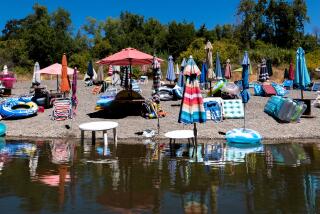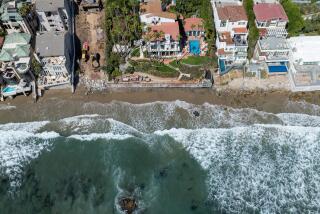Where Life Is a Beach
- Share via
AVILA BEACH — Try to see it through Beachcomber Bill’s eyes. William Price, 43-year-old son of Bakersfield, with a barrel chest, long, curly hair and easy manner, moved to this tiny town almost a dozen years ago and took over a beachfront shop from his ailing mother. He changed the name of the store to Beachcomber Bill’s, which by now is how most people here know him.
“That’s it, just ‘Beachcomber Bill,’ ” Beachcomber Bill said. “Most people don’t even know my last name.”
He stood behind the register, a reluctant interview. He kept turning away to gaze out the storefront window, which was crowded with displays of aloha shirts, straw hats, sandals and sand buckets. The window gave Beachcomber--Mr. Bill?--a ground-level view of one of Central California’s most popular beaches.
He could see salmon boats bobbing in San Luis Bay, the pier where whales sometimes surface to scrape off barnacles, sunbathing college students with their whitened noses stuck in textbooks, and children in hot but futile pursuit of sea gulls. He also could see this: Teams of overdressed strangers equipped with various probes and monitors, fanning across the beach and Front Street, Avila’s four-block main drag.
They had come to test for contaminants, to monitor a vast underground oil spill that has made Beachcomber Bill’s life at the beach something less than paradise. Even worse, from his perspective, the testers were trailed by two television camera crews. “You would think,” he growled, “it was the JonBenet Ramsey case or something.”
*
Spanish explorers discovered this natural harbor some 400 years ago. In the early 1900s, Big Oil rediscovered it. Oil was carried through a track of underground pipes from tankers to reservoirs located on a hill just above town. The tanks are still there, painted a sickly green. So are the pipes, and the pipes have been leaking--for how long, nobody knows.
In 1989 a would-be developer stumbled upon a subsurface plume of oil situated below Front Street and stretching below the bay. Since then, Unocal, owner of said pipes, has dickered along with county officials, townsfolk and many lawyers over what hazards--if any--the mess poses, and how--if at all--to clean it up. An environmental impact report issued last week recommended that Front Street and its shops be torn apart for a thorough excavation. Unocal would prefer to contain the plume with concrete and chemical treatments.
The townsfolk themselves--there are only a few hundred--are divided between those who would take Unocal to the cleaners and those who would rather take their chances living quietly above an oil plume than dealing with the publicity lawsuits generate.
“Don’t get me started, or I am liable to toss you out of here,” one restaurant owner raged, literally taking off his quilted kitchen gloves. “You guys go home fat and happy, have a big dinner. We are the ones who live here with this. We are the ones who have to worry about feeding a family.”
It was noon, and the place was all but empty.
*
A few doors down, Beachcomber Bill offered a less hostile reception. For whatever reason, aloha shirts and sandals have been moving. He defined himself as “not pro-Unocal and not anti-Unocal.” He does believe, however, that the hazards have been overblown--”swimming at our beach is safer than breathing L.A.’s air,” is how he put it--and that the cleanup debate has dragged on too long. Still, he said, if it comes to excavation, he will live with it and “be first in line to start back up. I am staying here. I am a survivor.”
His concern is that the town might be remade into, as he put it, “another Laguna Beach.” It’s not an uncommon fear, the notion that a tear-down ultimately would bring in developers with fancier designs and fancier lease rates. What gives Avila its charm are the trendy amenities it lacks. It’s a California museum piece, a funky, single-story beach town frozen in the early 1950s. No fancy promenade. No fancy malls. No fancy anything.
“We also don’t have any graffiti,” B. Bill said. “We don’t have barbed wire. We don’t even have parking meters.”
What they do have is that nasty oil. At this point, Beachcomber Bill simply would like the matter resolved. Let the reporters go away, the tourists return, the town knit itself back together. “This town has been tested,” he said. “A lot of people aren’t talking to each other.” Eight years is a long time. Unfortunately, in matters like this, time is almost always on the side of lawyers, bureaucrats, corporate executives, reporters--everybody but the Beachcomber Bills, caught in the middle. At least that’s how he sees it, looking out his window, watching the scavengers work the beach.
More to Read
Sign up for The Wild
We’ll help you find the best places to hike, bike and run, as well as the perfect silent spots for meditation and yoga.
You may occasionally receive promotional content from the Los Angeles Times.







